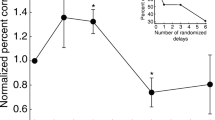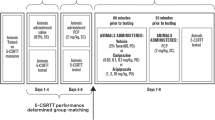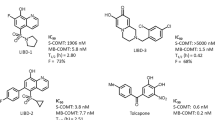Abstract
Background
The majority of studies assessing executive function in attention deficit disorder (ADD) have shown deficits in attentional set shifting using either the Wisconsin card sorting task or the intra-dimensional/extra-dimensional set-shifting task (ID/ED). Damage to the prefrontal cortex in humans, primates, and rodents impairs extra-dimensional (ED) shifts. Noradrenergic depletion of the medial prefrontal cortex in rats is sufficient to impair attentional set shifting. Atomoxetine, a selective norepinephrine (NE) re-uptake inhibitor, is hypothesized to produce beneficial effects in patient with ADD by augmenting NE release in prefrontal cortex.
Materials and methods
We assessed the effects of systemic administration of atomoxetine (0.0, 0.1, 0.3, and 0.9 mg/kg/ml) in normal and noradrenergically lesioned (NE-LX) rats on attentional-set shifts. We replicated findings showing NE-LX rats are selectively impaired on the ED shifts but not reversals or other discriminations.
Results
Atomoxetine remediated the attentional set-shifting impairments in NE-LX rats but impaired ED performance of non-lesioned rats.
Discussion
Though atomoxetine is neurochemically selective, it is not wholly specific at doses >0.3 mg/kg. All doses of the drug were similar in their efficacy in reversing the ED deficit, but the effectiveness of the 0.1 mg/kg dose supports the hypothesis that increases in prefrontal NE alone are sufficient to improve attention in NE-LX rats. Moreover, the detrimental effects of the drug in non-lesioned rats support the hypothesis that optimal levels of NE in prefrontal cortex are critical to attentional set shifting with both supra- and sub-optimal levels producing attentional impairments.





Similar content being viewed by others
References
Abercrombie ED, Zigmond MJ (1989) Partial injury to central noradrenergic neurons: reduction of tissue norepinephrine content is greater than reduction of extracellular norepinephrine measured by microdialysis. J Neurosci 9:4062–4067
Arnsten AF (1997) Catecholamine regulation of the prefrontal cortex. J Psychopharmacol 11:151–162
Arnsten AFT (1998) Catecholamine modulation of prefrontal cortical cognitive function. Trends Cogn Sci 2:436–447
Arnsten AFT (2006) Fundamentals of attention-deficit/hyperactivity disorder: circuits and pathways. J Clin Psychiatry 67:4–9
Arnsten AFT, Li B-M (2005) Neurobiology of executive functions: catecholamine influences on prefrontal cortical functions. Biol Psychiatry 57:1377–1384
Aston-Jones G, Cohen JD (2005) An integrative theory of locus coeruleus-norepinephrine function: adaptive gain and optimal performance. Annu Rev Neurosci 28:403–450
Aston-Jones G, Rajkowski J, Kubiak P, Alexinsky T (1994) Locus coeruleus neurons in monkey are selectively activated by attended cues in a vigilance task. J Neurosci 14:4467–4480
Aston-Jones G, Rajkowski J, Cohen J (2000) Locus coeruleus and regulation of behavioral flexibility and attention. Prog Brain Res 126:165–182
Barkley RA (1997) Behavioral inhibition, sustained attention, and executive functions: constructing a unifying theory of ADHD. Psychol Bull 121:65–94
Berridge CW, Devilbiss DM, Andrzejewski ME, Arnsten AFT, Kelley AE, Schmeichel B, Hamilton C, Spencer RC (2006) Methylphenidate preferentially increases catecholamine neurotransmission within the prefrontal cortex at low doses that enhance cognitive function. Biol Psychiatry 60:1111–1120
Birrell J, Brown V (2000) Medial frontal cortex mediates perceptual attentional set shifting in the rat. J Neurosci 20:4320–4324
Blondeau C, Dellu-Hagedorn F (2007) Dimensional Analysis of ADHD subtypes in rats. Biol Psychiatry 61:1340–1350
Bucci DJ, Holland PC, Gallagher M (1998) Removal of cholinergic input to rat posterior parietal cortex disrupts incremental processing of conditioned stimuli. J Neurosci 18:8038–8046
Bymaster FP, Katner JS, Nelson DL, Hemrick-Luecke SK, Threlkeld PG, Heiligenstein JH, Morin SM, Gelhert DR, Perry KW (2002) Atomoxetine increases extracellular levels of norepinephrine and dopamine in prefrontal cortex of rat: a potential mechanism for efficacy in attention deficit/hyperactivity disorder. Neuropsychopharmacology 27:699–711
Caballero J, Nahata MC (2003) Atomoxetine hydrochloride for the treatment of attention-deficit/hyperactivity disorder. Clin Ther 25:3065–3083
Castellanos FX, Tannock R (2002) Neuroscience of attention deficit/hyperactivity disorder: the search for endophenotypes. Neuroscience 3:617–628
Chamberlain SR, Muller U, Blackwell AD, Clark L, Robbins TW, Sahakian BJ (2006) Neurochemical modulation of response inhibition and probabilistic learning in humans. Science 311:861–863
Chamberlain SR, del Campo N, Dowson J, Müller U, Clark L, Robbins TW, Sahakian BJ (2007) Atomoxetine improved response inhibition in adults with attention deficit/hyperactivity disorder. Biol Psychiatry 62(9):977–984
Chiba AA, Bucci DJ, Holland PC, Gallagher M (1995) Basal forebrain cholinergic lesions disrupt increments but not decrements in conditioned stimulus processing. J Neurosci 15:7315–4322
Christman AK, Fermo JD, Markowitz JS (2004) Atomoxetine, a novel treatment for attention-deficit–hyperactivity disorder. Pharmacotherapy 24:1020–1036
Chudasama Y, Dalley JW, Nathwani F, Bouger P, Robbins TW (2004) Cholinergic modulation of visual attention and working memory: dissociable effects of basal forebrain 192 IgG-saporin lesions and intra-prefrontal infusions of scopolamine. Learn Memory 11:78–86
Dalley JW, McGaughy J, O'Connell MT, Cardinal RN, Levita L, Robbins TW (2001) Distinct changes in cortical acetylcholine and noradrenaline efflux during contingent and non-contingent performance of a visual attentional task. J Neurosci 21:4908–4914
Dalley JW, Cardinal RN, Robbins TW (2004) Prefrontal executive functions in rodents: neural and neurochemical substrates. Neurosci Biobehav Rev 28:771–784
Devauges V, Sara SJ (1990) Activation of noradrenergic system facilitates an attentional shift in the rat. Behav Brain Res 39:19–28
Dias R, Robbins T, Roberts A (1996a) Dissociation in prefrontal cortex of affective and attentional shifts. Nature 380:69–72
Dias R, Robbins T, Roberts A (1996b) Primate analogue of the Wisconsin card sorting test: effects of excitotoxic lesions of the prefrontal cortex in the marmoset. Behav Neurosci 110:872–886
Eagle DM, Robbins TW (2003) Inhibitory control in rats performing a stop-signal reaction time task: effects of lesion of the medial striatum and d-amphetamine. Behav Neurosci 117:1302–1317
Eagle DM, Baunez C, Hutcheson DM, Lehmann O, Shah AP, Robbins TW (2008) Stop-signal reaction time task performance: role of prefrontal cortex and subthalamic nucleus. Cereb Cortex 18(1):977–984
Faraone SV, Khan SA (2006) Candidate gene studies of attention-deficit/hyperactivity disorder. J Clin Psychiatry 67:10–17
Friedman JI, Adler DN, Davis KL (1999) The role of norepinephrine in pathophysiology of cognitive disorders: potential applications to the treatment of cognitive dysfunction in schizophrenia and alzheimer's disease. Biol Psychiatry 46:1243–1253
Granon S, Passetti F, Thomas KL, Dalley JW, Everitt BJ, Robbins TW (2000) Enhanced and impaired attentional performance after infusion of D1 dopaminergic receptor agents into rat prefrontal cortex. J Neurosci 20:1208–1215
Holley LA, Turchi J, Sarter M (1995) Dissociation between the attentional effects of infusions of a benzodiazepine receptor agonist and an inverse agonist into the basal forebrain. Psychopharmacology 120:99–108
Koob G, LeMoal M (1997) Drug abuse: hedonic homeostatic dysregulation. Science 278:52–57
Kratochvil CJ, Vaughn BS, Harrington MJ, Burke WJ (2003) Atomoxetine: a selective noradrenergic reuptake inhibitor for the treatment of attention-deficit/hyperactivity disorder. Expert Opin Pharmacother 4:1165–1174
Kratochvil CJ, Wilens TE, Greenhill LL, Gao H, Baker KD, Feldman PD, Gelowitz DL (2006) Effects of long-term atomoxetine treatment for young children with attention-deficit/hyperactivity disorder. J Am Acad Child Adolesc Psych 45:919–927
Lapiz MDS, Morilak DA (2006) Noradrenergic modulation of cognitive function in rat medial prefrontal cortex as measured by attentional set shifting capability. Neuroscience 137:1039–1049
Lapiz MDS, Bondi CO, Morilak DA (2007) Chronic treatment with desipramine improves cognitive performance of rats in an attentional set-shifting test. Neuropsychopharmacology 32(5):1000–1010
McAlonan K, Brown VJ (2003) Orbital prefrontal cortex mediates reversal learning and not attentional set shifting in the rat. Behav Brain Res 146:97–103
McGaughy J, Sarter M (1995) Effects of chlordiazepoxide and scopolamine but not aging on the detection and identification of conditional visual stimuli. J Gerontol: Biol Sci 50:B90–96
McGaughy J, Sarter M (1998) Sustained attention performance in rats with intracortical infusions of 192 IgG-saporin-induced cortical cholinergic deafferentation: effects of physostigmine and FG 7142. Behav Neurosci 112:1519–1525
McGaughy J, Kaiser T, Sarter M (1996) Behavioral vigilance following infusions of 192 IgG-saporin into the basal forebrain: selectivity of the behavioral impairment and relation to cortical AChE-positive fiber density. Beh Neuro 110:247–265
McGaughy J, Turchi J, Sarter M (1994) Crossmodal divided attention in rats: effects of chlordiazepoxide and scopolamine. Psychopharmacology 115:213–220
McGaughy J, Decker MW, Sarter M (1999) Enhancement of sustained attention performance by the nicotinic receptor agonist ABT-418 in intact but not basal forebrain-lesioned rats. Psychopharmacology 144:175–182
McGaughy J, Ross RS, Eichenbaum H (2008) Noradrenergic, but not cholinergic deafferentation of prefrontal cortex impairs atentional set-shifting. Neuroscience. doi:10.1016/j.physletb.2003.10.071
McGaughy J, Everitt BJ, Robbins TW, Sarter M (2000) The role of cortical cholinergic afferent projections in cognition: impact of new selective immunotoxins. Behav Brain Res 115:251–263
McGaughy J, Dalley JW, Morrison CH, Everitt BJ, Robbins TW (2002) Selective behavioral and neurochemical effects of cholinergic lesions produced by intrabasalis infusions of 192 IgG-saporin on attentional performance in a 5 choice serial reaction time task. J Neurosci 22:1905–1913
Mehta MA, Goodyer IM, Sahakian BJ (2004) Methylphenidate improves working memory and set-shifting in AD/HD: relationships to baseline memory capacity. J Child Psychol Psychiatry 45:293–305
Milstein JA, Lehmann O, Theobald DEH, Dalley JW, Robbins TW (2007) Selective depletion of cortical noradrenaline by anti-dopamine beta-hydroxylase saporin impairs attentional function and enhances the effects of guanfacine in the rat. Psychopharmacology 190:51–63
Owen AM, Roberts AC, Polkey CE, Sahakian BJ, Robbins TW (1991) Extra-dimensional versus intra-dimensional set-shifting performance following frontal lobe excisions, temporal lobe excisions or amygdalohippocampectomy in man. Neuropsychologia 29:993–1006
Owen AM, Roberts AC, Hodges JR, Summers BA, Polkey CE, Robbins TW (1993) Contrasting mechanisms of impaired attentional set-shifting in patients with frontal lobe damage or Parkinson's disease. Brain 116:1159–1175
Paxinos G, Watson C (1986) The rat brain in stereotaxic coordinates. Second Edition. New York: Academic Press
Robbins TW (2000) Chemical neuromodulation of frontal-executive functions in humans and other animals. Exp Brain Res 133:130–138
Roberts A, Robbins TW, Everitt BJ, Muir JL (1992) A specific form of cognitive rigidity following excitotoxic lesions of the basal forebrain in marmosets. Neuroscience 47:251–264
Robinson ESJ, Eagle DM, Mar AC, Bari A, Banerjee G, Jiang X, Dalley JW, Robbins TW (2007) Similar effects of the selective noradrenaline reuptake inhibitor atomoxetine on three distinct forms of impulsivity in the rat. Neuropsychopharmacology. doi: 10.1038/sj.npp.1301487
Sagvolden T, Sergeant J (1998) Attention deficit/hyperactivity disorder—from branin dysfuncitons to behaviour. Behav Brain Res 94:1–10
Sarter M, Bruno JP (1998) Cortical acetylcholine, reality distortion, schizophrenia, and lewy body dementia: too much or too little cortical acetylcholine. Brain Cogn 38:297–316
Sarter M, Bruno JP (1999) Abnormal regulation of corticopetal cholinergic neurons and impaired information processing in neuropsychiatric disorders. Trends Neurosci 22:67–74
Sarter M, Bruno JP (2000) Cortical cholinergic inputs mediating arousal, attentional processing and dreaming: differential afferent regulation of the basal forebrain by telecephalic and brainstem afferents. Neuroscience 95:933–952
Schoenbaum G, Chiba AA, Gallagher M (2000) Changes in functional connectivity in orbitofrontal cortex and basolateral amygdala during learning and reversal training. J Neurosci 20:5179–5189
Sergeant JA, Guerts H, Oosterlaan J (2002) How specific is a deficit of executive function for attention-deficit/hyperactivity disorder? Behav Brain Res 130:3–28
Solanto MV (1984) Neuropharmacological basis of stimulant drug action in attention deficit disorder with hyperactivity: a review and synthesis. Psychol Bull 95:387–409
Spencer T, Biederman J, Wilens T, Prince J, Hatch M, Jones J, Harding M, Faraone SV, Seidman L (1998) Effectiveness and tolerability of tomoxetine in adults with attention deficit hyperactivity disorder. Am J Psychiatr 155:693–695
Tait D, McGaughy J, Latimer MP, Brown V (2002) 192 IgG-saporin lesions of the cholinergic basal forebrain do not impair attentional set-shifting, but do increase latency to dig. Proceedings of the Society for Neuroscience, New Orleans, LA
Tait DS, Brown VJ, Farovik A, Theobald DE, Dalley JW, Robbins TW (2007) Lesions of the dorsal noradrenergic bundle impair attentional set-shifting in the rat. Eur J Neurosci 25:3719–3724
Turchi J, Holley LA, Sarter M (1995) Effects of nicotinic acetylcholine receptor ligands on behavioral vigilance in rats. Psychopharmacology 118:195–205
Tzavara ET, Bymaster FP, Overshiner CD, Davis RJ, Perry KW, Wolff M, McKinzie DL, Witkin JM, Nomikos GG (2007) Procholinergic and memory enhancing properties of the selective norepinephrine uptake inhibitor atomoxetine. Mol Psychiatry 11:187–195
Viggiano D, Ruocco LA, Arcieri S, Sadile AG (2004a) Involvement of norepinephrine in the control of activity and attentive processes in animal models of attention deficit hyperactivity disorder. Neural Plast 11:133–149
Viggiano D, Vallone D, Sadile A (2004b) Dysfunctions in dopamine systems and ADHD: evidence from animals and modeling. Neural Plast 11:97–114
Wee S, Woolverton WL (2004) Evaluation of the reinforcing effects of atomoxetine in monkeys: comparison to methylphenidate and desipramine. Drug Alcohol Depend 75:271–276
Wilens TE (2006) Mechanisms of action of agents used in attention-deficit/hyperactivity disorder. J Clin Psychiatry 67:29–34
Wong DT, Threlkeld PG, Best KL, Bymaster FP (1982) A new inhibitor of norepinephrine uptake devoid of affinity for receptors in rat brain. J Pharmacol Exp Ther 222:61–65
Acknowledgments
The authors thank Nicolas Adams and David Creer for excellent technical assistance.
Author information
Authors and Affiliations
Corresponding author
Rights and permissions
About this article
Cite this article
Newman, L.A., Darling, J. & McGaughy, J. Atomoxetine reverses attentional deficits produced by noradrenergic deafferentation of medial prefrontal cortex. Psychopharmacology 200, 39–50 (2008). https://doi.org/10.1007/s00213-008-1097-8
Received:
Accepted:
Published:
Issue Date:
DOI: https://doi.org/10.1007/s00213-008-1097-8




